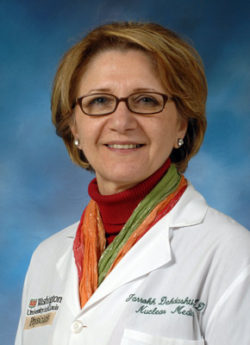Farrokh Dehdashti, MD

Farrokh Dehdashti, MD, professor of radiology at Mallinckrodt Institute of Radiology, is honored for her seminal efforts to identify and expand the role of positron emission tomography (PET) in the field of oncology.
An innovative translational researcher, Dehdashti focuses on applying PET imaging to the diagnosis and treatment of cancer. She is credited with conducting first-in-man studies of several novel PET diagnostic compounds related to cervical, breast and prostate cancers and has advanced the use of PET for detecting tumor hypoxia and tracking chemotherapy and radiation sensitivity and resistance. Her early research on steroid hormones in breast cancer was the first to show that PET using F-18 fluoroestradiol (FES), an estrogen analogue, can reliably and noninvasively assess tumor estrogen receptor status and can be used to predict response to endocrine therapy. That work was groundbreaking in its potential to save patients from having to undergo numerous invasive biopsies and being treated with an ineffective endocrine therapy.
Dehdashti holds Investigational New Drug (IND) status from the Food and Drug Administration to investigate several other radiotracers and recently translated a novel progesterone receptor radiotracer to assess whether it can accurately predict a response to endocrine therapy. She co-leads the Oncologic Imaging Program at the Alvin J. Siteman Cancer Center at Barnes-Jewish Hospital and Washington University School of Medicine, and her colleagues note that her ongoing contributions are a significant reason that the program scored “exceptional” in the last competitive review.
Dehdashti earned her medical degree from Pahlavi University School of Medicine in Iran in 1977 and completed her radiology residency in 1980 at the same institution. She served as chief resident and then research fellow in PET imaging in the division of nuclear medicine at Washington University School of Medicine before joining the faculty in 1990.




